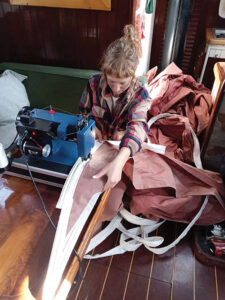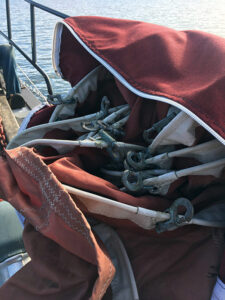
A new sewing machine becomes a favorite tool when an opportunistic sail repair job is needed while underway.
I’ve needed to use a lot of unfamiliar tools since entering the world of boat refits. Three years ago, I started out with a sledgehammer, then progressed through bevels and table saws to the trickiest tool I’ve used so far — a sewing machine. Intricate, finicky, and fairly expensive, sewing machines are the polar opposite of sledgehammers, and the gulf between these tools reflects how far I’ve come. My 1965 Pearson Triton, Hecate, has transformed from a slimy derelict into a handsome vessel, and I’ve transformed from a greenhorn into a handyma’am.
After several years of work on my boat, which entailed replacing virtually every single part of it, the only thing that still looks a little ratty is the mainsail cover. My first mainsail, which came with the boat, didn’t get a cover. It didn’t deserve one. But my second, and current, mainsail, a thing of beauty, got a hand-me-down Leitch McBride cover. It fits my black-and-white color scheme and keeps the sun off my sail, but half of the fasteners are missing and the seams are coming apart, so I always knew I’d want to replace it when I got a chance. Doing so has finally risen to the top of my prioritized to-do list, but rather than simply buy a new cover, I decided to take the long road and buy a Sailrite sewing machine so I could make my own.
I’d been thinking of buying a sewing machine for a while, but had always been intimidated by them. My mother’s machine, which I sometimes came across in the cupboard, was heavy and ugly, and the thread bewilderingly passed through some eight-or-so places from the spool to the needle. I liked the idea of sewing my own clothing, and after I got a sailboat I liked the idea of reupholstering my settee cushions, but I couldn’t motivate myself to buy a sewing machine when I was frequently moving from one cramped rental to another. None of my friends had sewing machines, so I couldn’t borrow theirs, and this also contributed to their intimidation factor. My boyfriend Trevor, who seemed to have every other tool I’d ever heard of, didn’t have one. But when I mentioned my dream of sewing myself a mainsail cover, he encouraged me to buy a sewing machine and learn how to use it.

As it turned out, I really needed the encouragement. When the Sailrite arrived we assembled it together, plugging in the pedal as the final step; but when I turned on the machine, the needle started plunging up and down vigorously, without anyone pressing the pedal. At first, we thought the pedal simply needed to be adjusted, but after opening the casing we discovered that one of the wires was completely unattached and needed to be re-soldered — and this was a brand new pedal! Thankfully, Trevor had the equipment and know-how to complete the repair and quickly re-soldered the wiring and, when we plugged it back in, the pedal worked properly.
Still, my confidence had been shaken, and I didn’t get around to threading the machine for another week. Eventually, I sewed a few strips of cloth together for practice, and then bought some fabric I liked and sewed a few cushion covers. My progress was modest, but I was relieved that I’d now learned enough to thread the machine without having to open the instruction manual each time. I expected that it would be a while until I sewed my new cover or anything else “boaty,” but then the unexpected happened.
Early one morning, Trevor and I motored out of Pender Harbour on his sailing ketch, Bunga Raya, intending to reach Vancouver later that day. The wind soon picked up and we raised the mainsail and cut the engine. However, under mainsail alone, we slowed to a pace that wouldn’t get us to Vancouver before dark. We needed to keep to our schedule, but the real workhorse sail — the roller-furling headsail — was already in Vancouver with the sailmaker who was repairing it; and collecting it was actually one of the reasons we were going to Vancouver in the first place. The other sails were not well suited to our point of sail or the wind conditions, which quickly rose to 20 knots. The mizzen sail provided little efficiency for running downwind. There was a hank-on staysail, which we raised, but without a foresail the boat was somewhat unbalanced, with an overpowered stern. We also thought about putting up an asymmetric spinnaker, but the wind was too strong; it would have been a pain to raise and then fuss over.

We hemmed and hawed some more about what to do before Trevor suggested we use his old hank-on foresail. All I needed to do was cut the luff off the sail, where the hanks were, and sew a bolt-rope luff in its place so it could fit in the roller furling foil. He happened to have a spare bolt rope, which he’d taken off an old sail before it went to the dump, with the intention of someday putting it to use. He figured it would probably be the same length, more or less, and that it would be pretty easy for me to attach it to the sail with my sewing machine, which I’d brought along with us, thinking I might have time to sew more cushion covers. It was a sudden leap forward for me, but I couldn’t resist the prospect of stepping into a real-life Sailrite commercial.
The hank-on jib’s foot was much smaller than the usual headsail, but it still filled the interior of Bunga Raya. I re-threaded the machine with UV-resistant thread and used double-sided tape to stick the bolt rope in place, in preparation for sewing. I had bought these items and a stack pack kit online at the Sailrite store at the same time as the sewing machine, figuring I would use them one day in the future, when I was finally confident enough to make myself a new mainsail cover. I hadn’t imagined I would end up using them so soon.
I sewed the 50 foot bolt rope on a few feet at a time. Trevor alternated between checking that the coast was clear up in the wheelhouse and helping me feed the sail through the machine. The luff puckered a little in some places, but the stitch tension was properly set, and I happily zig-zagged from head to tack. When the sail was finished, we hauled it up to the bow and fed the bolt rope into the roller furler, hoisting the tanbark sail against the blue sky. We picked up speed, and didn’t turn the engine on again until we were sailing past the container ships in Vancouver’s Burrard Inlet at dusk. Success!

It turns out, sewing modifications on old sails is easier than sewing cushion covers. Sails are large enough that a few wobbling seams go mostly unnoticed, but cushions are small and viewed up-close. It wasn’t until I sewed my ninth cushion that turned out “just right.” I still have a ways to go before I’m ready to sew a new stackpack for my mainsail, but I’ve been happily practicing on many projects. Between our two boats, there’s a ton of things to be fixed, altered, and made new; and it is empowering to think I have the equipment and am developing some of the skills to complete those projects. It’s doubly exciting to think that I can work on them anywhere I have power to run the machine and the motivation to try — whether at a dock, at anchor or, as I learned in this unique experience on Bunga Raya, underway! Sewing machines are my new favorite tool.
Emma Biron lives in Pender Harbour, B.C., and can often be seen sailing her Pearson Triton 28 around the harbor and beyond. In addition to sailing, she loves reading, writing, refits, and rowing.
Emma Biron
Emma Biron lives in Pender Harbour, BC, and can often be seen sailing her Pearson Triton 28 around the harbour and beyond. In addition to sailing, she also loves reading, writing, refits, and rowing.






